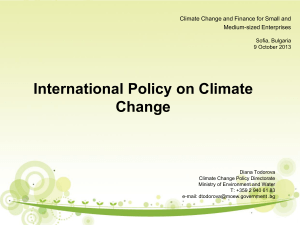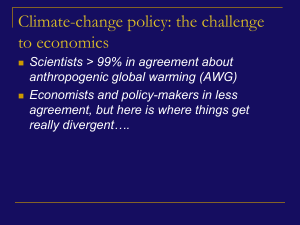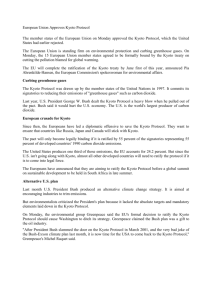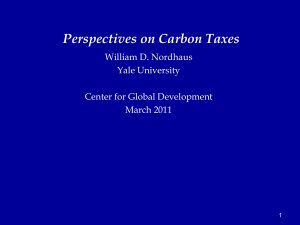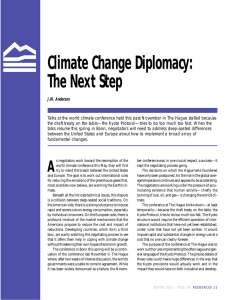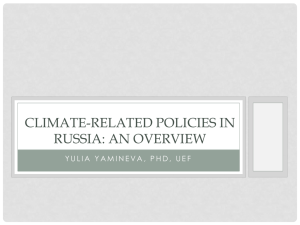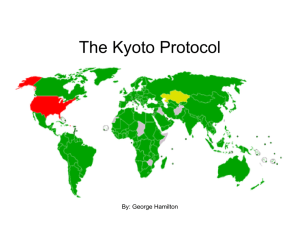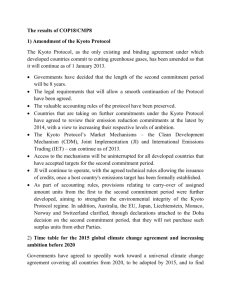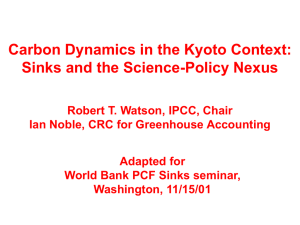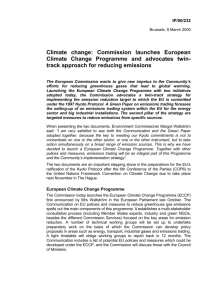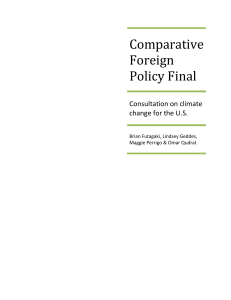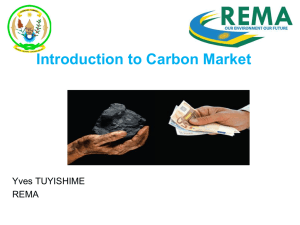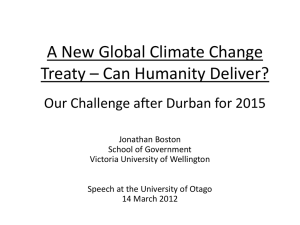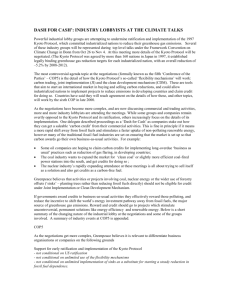DOC
advertisement
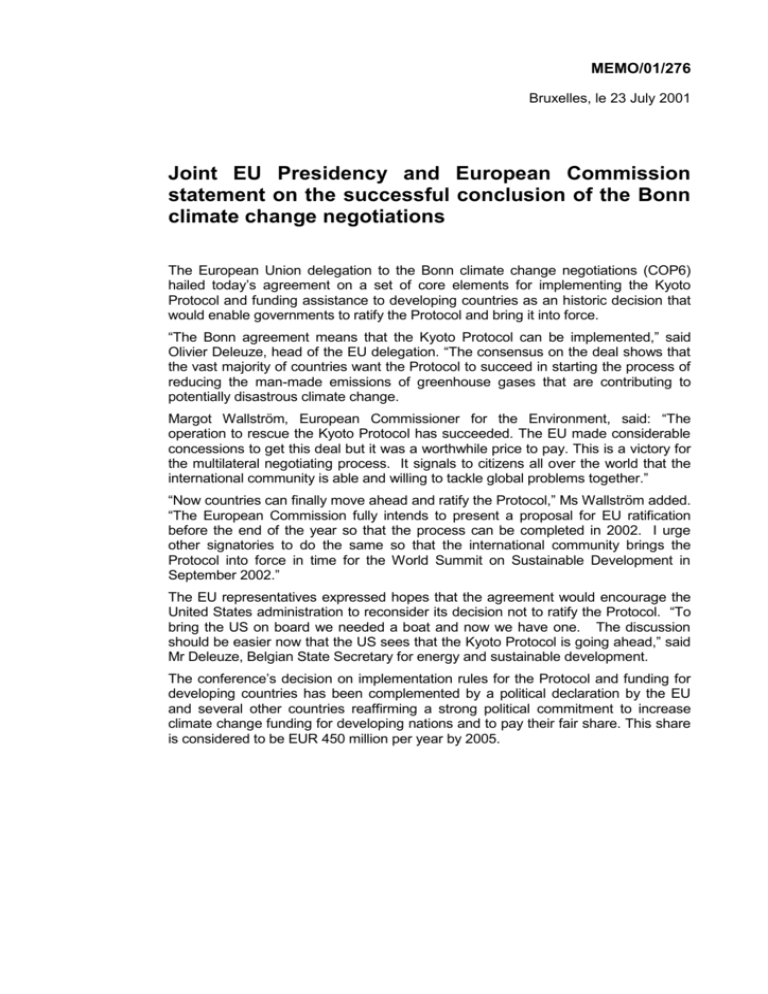
MEMO/01/276 Bruxelles, le 23 July 2001 Joint EU Presidency and European Commission statement on the successful conclusion of the Bonn climate change negotiations The European Union delegation to the Bonn climate change negotiations (COP6) hailed today’s agreement on a set of core elements for implementing the Kyoto Protocol and funding assistance to developing countries as an historic decision that would enable governments to ratify the Protocol and bring it into force. “The Bonn agreement means that the Kyoto Protocol can be implemented,” said Olivier Deleuze, head of the EU delegation. “The consensus on the deal shows that the vast majority of countries want the Protocol to succeed in starting the process of reducing the man-made emissions of greenhouse gases that are contributing to potentially disastrous climate change. Margot Wallström, European Commissioner for the Environment, said: “The operation to rescue the Kyoto Protocol has succeeded. The EU made considerable concessions to get this deal but it was a worthwhile price to pay. This is a victory for the multilateral negotiating process. It signals to citizens all over the world that the international community is able and willing to tackle global problems together.” “Now countries can finally move ahead and ratify the Protocol,” Ms Wallström added. “The European Commission fully intends to present a proposal for EU ratification before the end of the year so that the process can be completed in 2002. I urge other signatories to do the same so that the international community brings the Protocol into force in time for the World Summit on Sustainable Development in September 2002.” The EU representatives expressed hopes that the agreement would encourage the United States administration to reconsider its decision not to ratify the Protocol. “To bring the US on board we needed a boat and now we have one. The discussion should be easier now that the US sees that the Kyoto Protocol is going ahead,” said Mr Deleuze, Belgian State Secretary for energy and sustainable development. The conference’s decision on implementation rules for the Protocol and funding for developing countries has been complemented by a political declaration by the EU and several other countries reaffirming a strong political commitment to increase climate change funding for developing nations and to pay their fair share. This share is considered to be EUR 450 million per year by 2005. Summary of the key elements of the Bonn agreement on climate change The decision, adopted by consensus by Parties to the UN Framework Convention on Climate Change (UN FCCC), covers core elements for the implementation of the Kyoto Protocol and funding for developing countries as required by the Buenos Aires Plan of Action, agreed by Parties in November 1998. Kyoto mechanisms • Use of the Kyoto Protocol’s mechanisms – international emissions trading, Joint Implementation (emissions-cutting investment projects by industrialised countries in other industrialised countries) and the clean development mechanism (emissions-cutting investment projects by industrialised countries in developing nations) – is to be supplemental to domestic action to reduce emissions. Domestic action is thus to constitute a “significant” element of the emissions reduction effort by industrialised countries. • Nuclear energy cannot be used to generate credits from investment projects under Joint Implementation or the clean development mechanism • A simplified procedure will be developed to help accelerate certain types of small-scale investment projects under the clean development mechanism, including renewable energy and energy efficiency projects • Revenues from 2% of the credits generated by clean development mechanism projects will be paid into a new Kyoto Protocol adaptation fund, designed to help developing countries that are particularly vulnerable to the adverse effects of climate change to meet their costs of adaptation. Carbon “sinks” (land-use, land-use change and forestry) Industrialised countries can use carbon absorbtion from forestry management activities up to a set limit in order to meet their emissions targets. Also, under the clean development mechanism, only sinks projects involving afforestation and reafforestation can be counted, up to a fixed limit. The EU is disappointed that no limit has been set on sinks from agricultural activities. Not counting the US, which has said it will not ratify the Protocol, the total amount of carbon that can be absorbed through overall sinks activities, including agriculture, is estimated at around 96 million tonnes/year, equivalent to about 70% of the emissions reduction commitment of industrialised countries (excluding the US) under the Protocol. 2 Funding for developing countries Parties agree that predictable and adequate levels of funding should be made available to developing countries and recognise the need for funding that is new and additional to existing financial resources. Three new funds will be established, two under the UN FCCC: • A special climate change fund to finance activities in the following areas: adaptation to climate change; technology transfer; energy, transport, industry, agriculture, forestry and waste management; and activities to assist fossil-fuel dependent developing countries to diversify their economies. • A least developed countries fund to support a work programme for these countries. Both of these funds will be operated by the Global Environment Facility (GEF). In addition, the activities of the GEF Trust Fund will be broadened, particularly to build the capacity in developing countries to respond to the challenges of climate change. • The third fund, the Kyoto Protocol adaptation fund, will be established under the Protocol to finance concrete adaptation projects and programmes in developing countries that ratify the Protocol. The funding provisions of the agreement have been complemented by a political declaration by the EU and several other developed countries – Canada, New Zealand, Switzerland and Iceland - reaffirming a strong political commitment to increase climate change funding for developing nations and to pay their fair share. This share is considered to be EUR 450 million per year by 2005 and is to be revised in 2008. At the same time, reporting and review of financial support will be strengthened and made more transparent. Compliance system The Kyoto Protocol has special features that require a strong compliance system: quantitative emissions reduction and limitation targets and deadlines for industrialised countries, and the creation of emission markets through the Kyoto mechanisms. The agreement establishes a compliance regime that has stricter and more elaborate rules than any existing multilateral environmental agreement. A compliance committee with facilitative and enforcement branches will assess Parties’ compliance with all the Protocol’s provisions. Although these will not be legally binding, the following tough consequences will apply for non-compliance with the targets: • The obligation for a Party to make up for each excess tonne emitted in the first commitment period through the deduction of this amount from its second period allowance, plus 30% extra to compensate for the environmental damage caused. • The requirement to develop a compliance action plan giving priority to domestic action to reduce emissions. • Suspension of a non-compliant Party’s eligibility to sell/transfer emissions certificates under trading until its compliance is re-established. 3 These rules are necessary for investors to have sufficient confidence in the markets created by the Kyoto mechanisms. When the Protocol enters into force, the Parties to the Protocol will have the possibility, at the first Conference of the Parties serving as the meeting of the Parties (COP/MOP 1), to strengthen the system even further by laying down the procedures on compliance, and notably the consequences for non-compliance, in a legal instrument. 4

